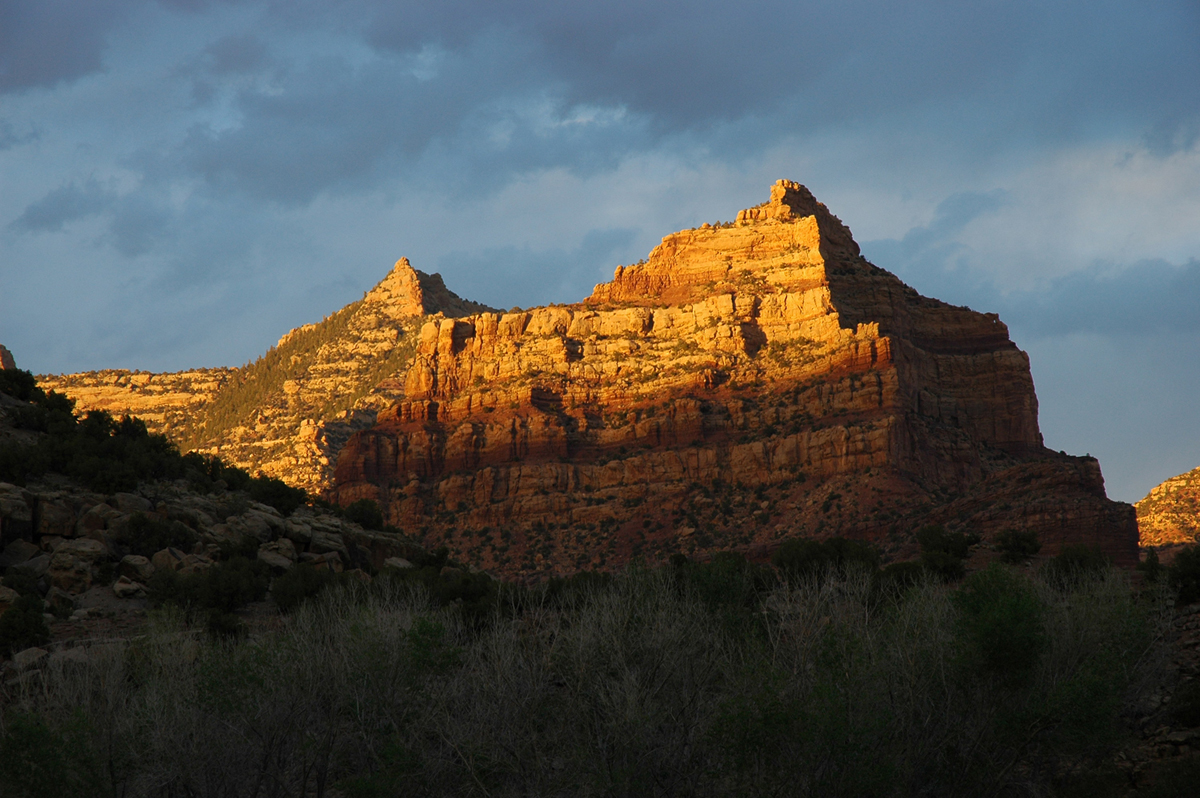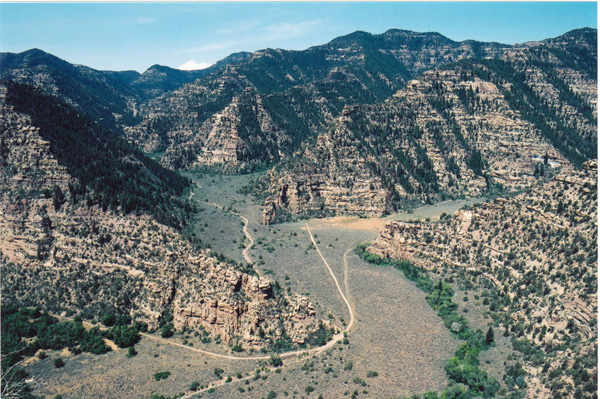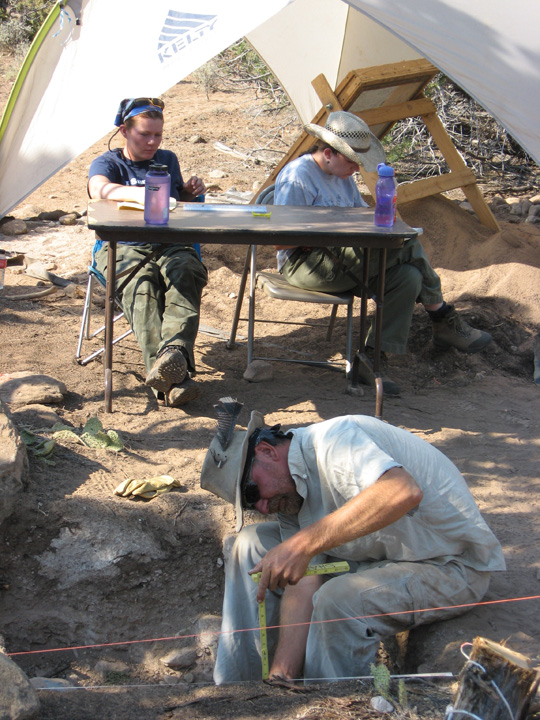The University of Utah's summer program in archaeological field techniques will be
held at Range Creek Canyon in east central Utah. Jointly sponsored by the Department
of Anthropology and the Natural History Museum of Utah, this course offers students
the opportunity to learn modern archaeological field and lab techniques in an ongoing
field research program. Under the direction of Dr. Shannon Boomgarden, participants
in the program will also receive training in archaeological method and theory.
Applications for 2026 are due by February 1, 2026
Please send the following by email to sboomgarden@nhmu.utah.edu.
- A one-page Statement of Interest, explaining your reasons for applying to the field program. (Please take this seriously as it not only tells us if our field school is a good fit for you but also provides a sample of your writing.)
- A list of any previous field and/or laboratory experience in archaeology or geoarchaeology, including dates, locations, and persons in charge.
- A letter of recommendation from an academic or professional in a related field.
- A copy of your college transcripts (this can be an unofficial transcript or DARS report).
- While not required, preference will be given to students who also submit a video/slide presentation introducing yourself and describing the following: Your professional academic goals, why you have chosen the Range Creek Field School, your research interests, and your experience with hiking, camping, and working in hot strenuous conditions.
- Application at link below:
Please direct all questions to sboomgarden@nhmu.utah.edu and put "Field School" in the subject line.
Course Description
The University of Utah's summer program in archaeological field methods will be held at Range Creek Canyon. Sponsored by the Department of Anthropology and the Natural History Museum of Utah, this eight-week field course is designed to teach basic archaeological field methods. Under the direction of Dr. Shannon Boomgarden, participants will receive training in a variety of field techniques including:
- Survey
- Mapping
- Soil identification
- Aspects of paleo-ecological research
Students will also have the opportunity to participate in a variety of experimental projects using traditional methods to farm small plots and/or collect wild resources. No previous experience is necessary, but some exposure to basic archaeological and anthropological concepts is recommended.
Admission to the field school is by application only and is limited to 12 students. Priority for admission will be given to those pursuing a professional career in archaeology or a related discipline. Applications are welcomed from both current University of Utah students, non-students and out-of-state students. Students will earn 8 semester upper division credits upon successful completion of the field school (ANTH 5712).
Participants must provide their own health insurance, a small tool kit, basic personal camping equipment, and transportation to the University of Utah.
Location and Setting
Range Creek Canyon (Map)
The University of Utah's summer program in archaeological field methods will be held
in Range Creek Canyon. Range Creek is a tributary of the Green River on the West Tavaputs
Plateau in east-central Utah. Extremely remote due to the rugged character of the
plateau, Range Creek is bordered by Nine Mile Canyon to the north, the Book Cliffs
to the west and south, and Desolation Canyon to the east. The canyon heads at about
10,200 feet in elevation and descends rapidly to its c onfluence with the Green River at an elevation of about 4,200 ft. The canyon itself
is extremely rugged, consisting basically of a narrow, sinuous canyon floor between
walls that tower nearly 3,000 feet overhead. The dozen or so named side-canyons that
open into Range Creek, as well as the many unnamed ones, provide even the casual visitor
with breathtaking vistas.
onfluence with the Green River at an elevation of about 4,200 ft. The canyon itself
is extremely rugged, consisting basically of a narrow, sinuous canyon floor between
walls that tower nearly 3,000 feet overhead. The dozen or so named side-canyons that
open into Range Creek, as well as the many unnamed ones, provide even the casual visitor
with breathtaking vistas.
A long section of the lower canyon floor was a privately-owned ranch until it was transferred to the Bureau of Land Management (BLM) in 2002. Although the ranch in the lower canyon includes only about 3,000 acres, it provides access to nearly an additional 50,000 acres in the canyon. In 2004, ownership of the ranch was transferred to the Utah Division of Wildlife Resources (DWR) and In 2009 the ownership transferred again to the School and Institutional Trust Lands Administration (SITLA).
The Natural History Museum of Utah at the University of Utah currently manages the property, which has been established as the Range Creek Field Station. Because of the long and vigilant efforts of the family that owned the ranch, and the dedicated efforts of subsequent managing agencies, the archaeological sites in the area are in excellent condition. The vast majority of the sites recorded to date are associated with the Fremont archaeological complex, which dates between about A.D. 500 and A.D. 1350.
Simply stated, Range Creek Canyon shares many similarities with world-famous Nine Mile Canyon, but without the 100 years of overt vandalism, visitor wear and tear, and development impacts. We are unaware of another region in the state of Utah that has the sheer number and density of essentially untouched archaeological sites. See the Natural History Museum of Utah's Range Creek website for more information.
Living Arrangements

Expect comfortable but relatively primitive living conditions. We will be camping at the headquarters of the field station which was a working ranch until a few years ago. Students are expected to provide their own camping equipment (personal tents, sleeping bags and pads, etc.). We have two indoor showers for student use but during droughts and excessive use there may not be enough water for students to shower daily. Other options include using biodegradable soap to rinse in the creek or pond or bringing your own sun shower bag. Meals during the ten-day work sessions will be prepared by a professional cook. Water, toilets, and archaeological field equipment (aside from the personal tool kit) will be provided by the field program. All students will be expected to assist in the daily camp chores required to keep a field camp running smoothly. Additionally, one day of each field session will be devoted to maintaining the ranch, and will include such activities as landscape upkeep, cutting firewood, painting, mowing, etc. It is a small price to pay for having access to the main ranch house for cooking facilities, the bunkhouse and a log cabin for research facilities. Students will also assist with cooking on a one-day rotational basis.
The ranch is in an extremely isolated part of Utah. Access is by a dugway (a dirt road cut into the side of a canyon wall by a bulldozer) that crosses an 8,700 foot pass. This road may be impassable when wet. In good weather, it takes more than 2 hours to travel from the ranch to the nearest major town, which is Price. For safety reasons, students are discouraged from bringing personal vehicles to the field. Cellular phones do not work in the canyon, although a satellite phone is available for emergencies. Due to the remote location of the field camp and limited by permit only access, students are not allowed to invite guests to visit the field school.
The course will consist of four 10-day field sessions separated by 4-day breaks. One or two vehicles will return to Salt Lake City at the beginning of each break and students have the option of staying in camp or going to Salt Lake City. Students wishing to remain in camp will be responsible for their own food and general camp management during the breaks. This option must be cleared and arranged with the site Manager, Corinne Springer. Students that stay in camp will have to help with camp maintenance and visitors/tours. Hiking and camping on your own is not allowed with in the locked gates.
The weather tends to be unpredictable and can change dramatically without notice. In general, expect hot days and warm nights, and dry weather punctuated by afternoon thunderstorms. This field season is sufficiently late in the year, so insects should not be a major problem, but students should be alert for rattlesnakes and black bears. The major problems are likely to be injuries due to falling, sunburn, dehydration and sore muscles. Bear in mind that this is a field school working out of a field camp: storms can blow down tents, flood sites, and trench roads; vehicles break down and get stuck; medical facilities are quite some distance away. Much of the success or failure of the field season will be a function of everyone cheerfully pitching in to overcome the adversities that are guaranteed to arise.
Research Agenda
Field schools provide a unique educational opportunity to train students in modern field techniques by investigating actual sites. Since archaeological sites are finite resources, protected by federal and state laws, and represent the sole source of knowledge about the past before written records, field schools are a blend of education and basic research. Research designs (the basic questions to be addressed through survey and excavation) are written, permits obtained and contractual obligations formed before entering the field. This is as true for a field school as it is for a professional archaeological investigation. Experience indicates that during the first part of a field school, training students is the foremost goal; during the last part of a field school, achieving research goals is the higher priority. This means that at first every attempt will be made to give each student experience with each field activity, but as the season progresses students will be assigned to tasks they perform best.
See the Utah Museum of Natural History's Range Creek website for more information.
Tuition
Students are responsible for paying full tuition as assessed by the University, and a $700.00 course fee for meals and transportation between SLC and the Field Station. View the full tuition schedule for the current academic year. Students should figure tuition according to the Resident fees, as there is no Non-Resident tuition assessed for summer courses. Note that tuition amounts are subject to change without notice. The exact tuition amount for Summer 2026 (which is part of the 2024-2026 academic year) will not be available until April 2026, but there is usually a 10% increase between one academic year and the next.
Required Equipment
Most field equipment will be provided. However, field school participants are required to assemble a small personal tool kit. This includes the tools and other equipment that are frequently used during survey and excavation. Many of the items are fairly common and students may find that they already own some of them.
Required Field School Tool Kit:
| Item | Approx cost |
| 5 meter tape measure | $10.00 |
| Clipboard | $1.00 |
| Protractor | $1.00 |
| 1 ft ruler with cm | $1.00 |
| Leather work gloves | $10.00 |
|
Trowel (Marshaltown recommended) |
$14.00 |
|
Compass (Silva Ranger recommended) Other brands purchased must have a mirror and 360 degree dial. |
$55.00 |
| TOTAL | ca. $92.00 |
Optional Additional Field School Tool Kit:
| Item | Approx cost |
| Pocket knife (preferably fixed large (3") blade) | $20.00 |
| folding metric ruler | $17.95 |
| TOTAL | ca. $37.95 |
Personal Equipment.
Expect hot days, cool nights, and lots of time in the sun.
Items
|
|
|
|
|
|
|
|
|
|
|
|
|
|
|
|
|
|
|
|
|
Enrollment and Application
Admission
Admission to the field school is limited to 12 students and applicants must complete the online application form. Please complete the application form and submit it along with a one-page statement of interest and transcript by email to sboomgarden@nhmu.utah.edu. Applications will be reviewed after the deadline and students will be notified within a few days.
Shannon Arnold Boomgarden
301 Wakara Way
Salt Lake City, UT 84108
Experience
No previous field experience is required for admission to the field school, but some exposure to the basic concepts of archaeology, anthropology or earth sciences is recommended. Applicants must also be able to meet the strenuous demands of archaeological survey and excavation in the rugged but scenic conditions of the Colorado Plateau.
Registration
University of Utah students accepted to the program should register for ANTH 5712 for 8 credit hours. The class (index) number will be provided to accepted participants in time for them to enroll for Summer 2026. If you are not a current University of Utah student you must apply to the University of Utah for non-matriculated status before you can enroll in the field school. Check University webpages for deadlines.
Credit hours and fees
All students must participate in the full eight-week field school and will receive 8 semester credits (view tuiton costs). In addition, there is a special fee of $700.00 for transportation and food. Documentation of payment of tuition must be completed by May 24, 2026. Note that tuition amounts are subject to change without notice. The exact tuition amount for Summer 2026 (which is part of the 2025-2026 academic year) will not be available until some time during April 2026, but there is usually a 10% increase between one academic year and the next.
Insurance
Participants must provide their own health insurance. Student health insurance plans are available through the University of Utah. Please contact:
Student Insurance Office
Wasatch Clinic
555 Foothill Blvd.
Salt Lake City, Utah 84112
1-801-585-6949
Documentation of payment of insurance must be submitted on June 8, 2026. Documentation may include a receipt or a current insurance card.
Equipment
Students must provide their own basic equipment in the form of a small tool kit. Arrangements can be made through the University of Utah Archaeological Center to borrow required high-cost field equipment.
Financial Assistance
Financial assistance must be obtained through the office of Scholarships and Financial Aid. There are also scholarships available through the College of Social and Behavioral Science every year for undergraduates.
Transportation
Students must provide their own transportation to Salt Lake City, Utah. Transportation assistance in the Salt Lake area (i.e., from the airport, bus station, etc.) to the University of Utah is available. Students should make arrangements at a local hotel or hostel in Salt Lake City on the breaks and for early arrival before sessions begin.
Staff
Shannon Arnold Boomgarden, PhD Field StationDirector/Instructor
Corinne Springer Site Manager/Archaeologist
Larry Coats Department of Geography: Paleoenvironmental Field Methods course joins the first session of field school each summer (GEOG 5712)
Jamie Greenland Lab Manager and Field Supervisor
Recommended Reading
The following reading is recommended. Many of these articles are available for download from the Marriott Library. This reading and more will be available in our field library for students to check out.
Boomgarden Shannon A. (2015) Experimental Maize Farming in Range Creek Canyon, Utah. Unpublished Ph.D. Dissertation, Department of Anthropology, University of Utah, Salt Lake City.
Boomgarden, Shannon A., Duncan Metcalfe, and Corinne Springer (2014) Prehistoric Archaeology in Range Creek Canyon, Utah: A Summary of Activities of the Range Creek Field Station. Utah Archaeology 27(1): 9-32.
Arnold, Shannon (2009) An Application of ArcGIS Viewshed Analysis in Range Creek Canyon, Utah. Utah Archaeology 22(1), pp. 15-30.
Prehistory of Utah
Kelly, R.L. (1997). Late Holocene Great Basin Prehistory. Journal of World Prehistory 11: 1-50.
Madsen, D.B. and Simms, S.R. (1998). The Fremont Complex: A Behavioral Perspective. Journal of World Prehistory, Vol. 12, No. 3: 255-336.
Simms, S.R. (2008) Ancient Peoples of the Great basin and Colorado Plateau. Left Coast Press: California.
Archaeology
Binford, L. (1980). Willow Smoke and Dogs' Tails: Hunter-Gatherer Settlement Systems and Archaeological Site Formation. American Antiquity 45: 4-20.
Metcalfe, D. (2008)Range Creek Canyon in The Great Basin: People and Place in Ancient Times, eds. C.S. Fowler and D.D. Fowler, School For Advanced Research Press:Santa Fe.
Metcalfe, D. and Barlow, K.R. (1992). A Model for Exploring the Optimal Tradeoff between Field Processing and Transport. American Anthropologist 94: 340-356.
O'Connell, J.F. (1993). What can Great Basin Archaeologists Learn from Prehistoric Site Structure? An Ethnoarchaeological Perspective. Utah Archaeology 1993: 7-26.
O'Connell, J.F. (1987). Alyawarra site structure and its archaeological implications. American Antiquity 57: 74-108.
Spangler, J.D. (2000). One-Pot Pithouses and Fremont Paradoxes: Formative Stage Adaptations in the Tavaputs Plateau Region of Northeastern Utah. In Intermountain Archaeology, Eds. Madsen and Metcalf, University of Utah Anthropological Papers, No. 122.
Spangler, J.D.,S.Arnold, and J. Boomgarden (2006). Chasing Ghosts: A GIS Analysis and Photographic Comparison of Vandalism and Site Degradation in Range Creek Canyon, Utah.
Theory
Bird, D. and O'Connell, J. (2006) Behavioral Ecology and Archaeology. Journal of Archaeological Research.
Climate and Geology
Benson et al. (2006) Possible impacts of early-11th, middle-12th-, and late-13th-century droughts on western Native Americans and the Mississippian Cahokians. Quaternary Sciences Reviews.
Cook et al. (2007) North American Drought: Reconstructions, Causes, and Consequenses. Earth Science Reviews 81:93-134.
Stokes William L. (1986) Geology of Utah UMNH and Utah Geological Survey: SLC
